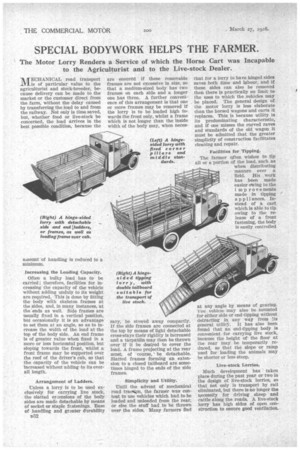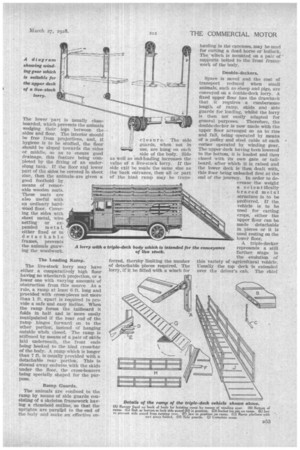SPECIAL BODYWORK HELPS THE FARMER.
Page 114

Page 115

Page 116

If you've noticed an error in this article please click here to report it so we can fix it.
The Motor Lorry Renders a Service of which the Horse Cart was Incapable to the Agriculturist and to the Live-stock Dealer.
ATECHANICAL road transport Lis of particular value to the agriculturist and stock-breeder, because delivery can be made to the market or the customer direct from the farm, without the delay caused by transferring the load to and from the railway. Not only is time saved, but, whether food or live-stock be concerned, the load arrives in the best possible condition, because the
amount of handling is reduced to a minimum.
Increasing the Loading Capacity.
Often a bulky load has to be carried ; therefore, facilities for increasing the capacity of the vehicle without adding unduly to its weight are required. This is done by fitting the body with skeleton frames at the sides, and, in many instances, at the ends as well. Side frames are usually fixed in a vertical position, but occasionally it is an advantage to set them at an angle, so as to increase the width of the load at the top of the body side. An end frame Is of greater yalue when fixed in a more or less horizontal position, but sloping towards the front, whilst a front frame may be supported over the roof of the driver's cab, so that the capacity of the vehicle can be Increased without adding to its overall length.
Arrangement of Ladders.
Unless a lorry is to be used exclusively for carrying live stock, the slatted ey tensions of the body sides are made detachable by means Of socket or staple fastenings. Ease of handling and gnater durability
D52 are ensured if these removable frames are not excessive in size, so that a medium-sized body has two frames on each side and a longer one has three. A further convenience of this arrangement is that one or more frames may be removed if the lorry is to be loaded high towards the front only, whilst a frame which is not longer than the inside width of the body may, when neces sary, be stowed away compactly. If the side frames are connected at the top by means of light detachable cross-stays their rigidity is increased and a tarpatilin may then be thrown over if it be desired to cover the load. A frame projecting at the rear must, of course, ' be detachable. Slatted frames forming an extension to a closed tailboard are sometimes hinged to the ends of the side frames.
Simplicity and Utility.
Until the advent of mechanical road trackl,on, the farmer was content to use vehicles which had to be loaded and unloaded from the rear, or else the stuff had to be thrown over the sides. Many farmers find
that for a lorry to have hinged sides saves both time and labour, and if these sides can also be removed then there is practically no limit to the uses to which the vehicles may be placed. The general design of the motor lorry is less elaborate than the horsed wagons and carts it replaces. This is because utility is its predominating characteristic, and if one misses the curved raves and standards of the old wagon it must be admitted that the greater simplicity of construction facilitates cleaning and repair.
Facilities for Tipping.
The farmer often wishes to tip all or a portion of the load, such as when distributing manure over a field. His work has been made easier (Acing to the improvements made in tipping appliances. Instead of a cart which is able to tip owing to the release of a front fastening, the body is easily controlled at any angle by means of gearing. 'une vehicle may also be mounted for either side or end-tipping without detracting in any way from :Its general utility. It has also been found that an end-tipping body is convenient for carrying live stock, because the height of the floor at the rear may be temporarily reduced, so that the slope or ramp used for loading the animals may be shorter or less steep.
Live-stock Lorries.
Much development has taken place during the past year or two in the design of live-stock lorries, so that not only is transport by rail eliminated, but there is no longer the necessity for driving sheep and cattle along the roads. A live-stock lorry has high sides of open construction to ensure good ventilation. The lower part is usually closeboarded, which prevents the animals wedging their legs between thesides and floor. The interior should be free from projections, and, if hygiene is to be studied, the floor should he sloped towards the sides or middle, so as to ensure good drainage, this feature being completed by the fitting of an underslung tank. If the floor and lower part of the sides be covered In sheet zinc, then the animals-are given a good foothold by means of removable wooden mats. These mats are also useful with an ordinary hardWoad floor. Covering the sides with sheet metal, wire netting or expanded metal, either fixed or in detachable frames, prevents
the animals gnawA lorry with ing the woodwork.
The Loading Ramp.
The live-stock lorry may have either a comparatively high floor having no wheelarch projection, or a lower one with varying amounts of obstruction from this source As a rule, a ramp at least 6 ft. long and provided with cross-pieces not More than 1 ft. apart is required to provide a safe and easy incline. When the ramp forms the tailboard it folds in half and is more easily manipulated if the rear end of the ramp hinges forward on to the Other portion, instead of hanging outside whe7n closed. The ramp is Stiffened by means of a pair of skids laid underneath, the front ends being hooked to the hind cross-bar of the body. A ramp which is longer than 7 ft. is usually provided with a detachable rear portion. This is stowed away endwise with the skids under the floor, the cross-bearers being specially shaped for the purpose.
Ramp Guards.
The animals are confined to the ramp by means of side guards consisting of a skeleton framework having a rhomboid outline, so that the uprights are parallel to the end of the hotly and make an effective en
hauling in the carcases, may be used for carting a dead horse or bullock. The 'winch is mounted on a pair of supports bolted to the front framework of the body.
Double-deckers.
Space is saved and the cost of transport reduced when small animals, such as sheep and pigs, are conveyed on a double-deck lorry. A fixed upper floor has the drawback that it requires .a cumbersome length of ramp, skids and side guards for loading, whilst the lorry is then not easily adapted for general purposes. Therefore, the double-decker is now made with the upper floor arranged so as to rise and fall, being operated by means of a pulley and steel cable at each • corner operated by winding gear. The upper deck having been lowered to the bottom, it is loaded and then closed with its own gate Or tailboard, after which it is raised and the lower deck is then dealt with, this floor being unloaded first at the end of the journey. In order to decrease the weight a scientifically braced metal structure is to be preferred. If the vehicle is to be used for carting crops, either the upper floor can be made detachable in pieces or it is used resting an the lower floor.
A triple-decker represents a still farther stage in the evolution of this variety of .agricultural vehicle. Usually the top deck Is extended over the driver's cab. The chief problem connected with the triple-deck lorry is whether, owing to the amount of gearing necessary, it is worth while to introduce lifting floors or it is better to rely on a somewhat cumbersome ramp, so that each height of floor may be made accessible in a satisfactory manner. Assuming that the floor is 3 'ft. off the ground and the ramp 7 ft. long, then the angle made by the ramp with the ground is about 25 degrees, which may be regarded as a safe and convenient angle for loading and unloading. If the • second floor be 2 ft. 6 ins, above the first one, then the ramp must be 12 ft. long if the same angle with the ground is to be preserved, and for the top deck, another 2 ft. 6 ins. higher Or 8 ft. from the ground, a ramp 18 ft. long would be necessary to give the same angle. If the ramp to the top floor be reduced to 14 ft. long then the angle is increased to 35 degrees and represents a compromise which would be found acceptable in most instances.
Raising and Lowering the Ramp.
The weight of the ramp can be reduced so as to render its handling easier by making it not more than 2 ft. 6 ins, wide or merely large enough for the passage of a sheep or pig. If the ramp is made to divide in half, the body is both long and high enough to afford plenty of space for hanging up the various parts. The same ramp would be used for loading all the decks, and, as the height it has 'to be raised is considerable, it is suggested that this operation be made easier by fastening a pair of metal guides at the hack of the body and a pair of pulleys at the top. Then the ramp could be raised or lowered to any desired height and detached at the chassis level.
If lifting floors are to be adopted, then a double set of winding gears and pulleys would be required. With a top deck carried over the
a driver's cab, this part would have to be loaded first and a gate or partition placed across. Then the floor would be lowered and raised again so as to loaethe larger portion 0 the top deck.
Value of Trailers.
Further improvementsare possible in the general design of far mem' lorries if forward-control types of chassis are available for this class of work, whilst the chassis which is driven from the front
wheels would be useful to the farmer, because it has a body space free of all transmission mechanism, an arrangement that allows of a low floor which requires no inspection traps. The articulated sixwheeler also gives the designer of the body plenty of scope, because not only is this practically a front driven chassis, but it is particularly suitable for bodies of maximum
• capacity.. T h e two and four-wheeled trailer is perhaps the ideal for live-stock transport, because it can have a low floor, and, when disconnected from the tractor, the front can be used as an exit, so that the animals may be released with a minimum of trouble. • Finally, in designing a body for the carriage of live stock, it is essential that special attention should be paid to facilitating the cleansing of the vehicle, or it will prove difficult to keep it in a sanitary condition.




























































































































































































